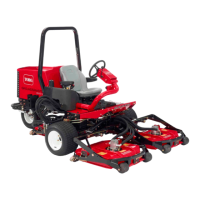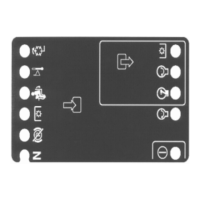41
3. Install filter by hand until gasket contacts mounting
head. Then rotate an additional 1/2 turn.
4. Start engine and check for hydraulic oil leaks. Allow
engine to run for about two minutes so any air in the
system is purged (removed).
5. Shut engine off and check level of hydraulic system;
refer to Checking the Hydraulic System Oil, page 21.
1
Figure 61
1. Hydraulic oil filter
Changing the Hydraulic
System Oil
The hydraulic system oil must be changed after every 250
hours of operation or seasonally, whichever comes first.
The hydraulic system is designed to operate on any high
quality detergent oil having the American Petroleum
Institute—APO—“service classification” SF/CC or CD. Oil
viscosity—weight—must be selected according to
anticipated ambient temperature for the season in which
product will be used.
Temperature/viscosity recommendations are:
Expected Ambient
Temperature
Recommended Viscosity
and Type
(Extreme) over 90° F SAE 30, Type SF/CC or CD
engine oil
(Normal) 40–100° F SAE 10W-30 or 10W-40,
Type SF/CC or CD engine oil
(Cool—Spring/Fall)
30–50° F
SAE 5W-30, Type SF/CC or
CD engine oil
(Winter) Below 30° F Type “F” or “FA” ATF
Automatic Transmission
Fluid
Note: Do not mix engine oil and automatic transmission
fluid or hydraulic system component damage may result.
When changing fluids, also change transmission filter. Do
not use Dexron II ATF.
Note: Fluid to operate the power steering is supplied by the
hydraulic system transmission charge pump. Cold weather
start–up may result in “stiff” operation of the steering until
the hydraulic system has warmed up. Using proper weight
hydraulic oil in system minimizes this condition.
The axle housing acts as the reservoir for the system. The
transmission and axle housing are shipped from the factory
with approximately 5 quarts (4.7 l) of SAE 10W-30 engine
oil. However, check level of transmission oil before engine
is first started and daily thereafter.
1. Start engine, park machine on a level surface, lower
implement to the shop floor, set the parking brake, and
shut engine off. Block the two rear wheels.
2. Jack up both sides of front axle and support it with jack
stands.
3. Clean area around hydraulic oil filter and remove filter.
4. Remove drain plug from fitting between axle housing
and oil filter and allow oil to flow into drain pan
(Fig. 62).
1
Figure 62
1. Drain plug
5. Install new filter; refer to steps 1–2 in Replacing
Hydraulic Oil Filter, for proper procedures.
6. Install drain plug in fitting between axle housing and oil
filter (Fig. 62).
7. Remove dipstick from axle filler tube (Fig. 63) and fill
axle to proper level with correct type and viscosity oil
recommended for expected ambient temperature
conditions; refer to table above.
8. Start and run the engine at idle speed for about two
minutes and turn the steering wheel lock to lock to
purge air trapped in the system. Shut the engine off.

